
A Sega Console Retrospective
Like the sea with its rising and falling tide, the business landscape has always been comprised of companies in various states of growth and decline; the gaming industry is certainly no exception to this rule. Very few companies have maintained a constant presence in the arcades and homes of players: Nintendo, Namco and Capcom come to mind as the few rare examples of these ever-present industry titans.
Today, I’d like to explore another company who —through thick and thin— has maintained a position in both the gaming industry and the minds of players all over the world. As you’ve no doubt already figured out from the title, we’re going to take a trip to the past and relive the highs (and lows) of Sega’s storied hardware past. So without further ado, let’s climb aboard this time-train to the amusement arcades of 1940s Hawaii…
“Standard” Beginnings
I know what you’re thinking: “Sega makes videogames, and there definitely weren’t any of those to be found in the 40s! What gives!?” Well observed of you, fear not though: all will make sense soon enough. You see, Sega technically began in Hawaii as “Standard Games”, a company that produced various coin-operated games and amusements for the American military. Not electronic games as we currently think of them mind you, but the kind of mechanical contraption that —inside— might resemble the inner workings of a grandfather clock.
Standard Games continued producing coin-operated pastimes all the way through the 40s and 50s, eventually moving its operation to Japan when slot machines were outlawed in the US and adopting a new name to match: “Service Games of Japan”. The 50s saw a steady growth for the company, although it came under pressure on account of tax evasion accusations as the 60s drew nearer. In 1960, Service Games of Japan officially dissolved; but its activities continued thanks to two newly established partner companies, one of which would merge with competitor Rosen Enterprises in 1965 to become Sega Enterprises Ltd.
Sega Enterprises Ltd. went from strength to strength with David Rosen in the Chairman position. As the 60s became the 70s, Sega leaned away from slot machines and into things resembling traditional arcade games (“resembling” being the key word here, they were still incredibly primitive). It’s first original game, Periscope released in 1966 and launched the company into a successful position in arcades all over the world. Throughout the 70s and 80s, the business grew further to acquire more companies, assets and influence. Sega was on top form, but the tide was soon to change with the advent of home game systems like the Atari 2600 and ColecoVision.
Coming to a Home Near You
 By Evan-Amos CC BY-SA 3.0
By Evan-Amos CC BY-SA 3.0
To keep up with the changing market, Sega released the SG-1000, its first home game console for Japanese consumers; accompanying it was the SC-3000, a computer equivalent. Both systems launched simultaneously and were more or less equals, barring a fully-featured keyboard and more user freedom on the SC-3000.
Here’s where things get interesting: this is where the rivalry between Nintendo and Sega began. Sega’s console and Nintendo’s own Famicom launched at the same time and directly competed with each other. Initially, the SG-1000 looked to be dominating the Famicom. Nintendo eventually began forming relationships with third-party developers however, and stormed ahead as the 80s matured. Making this an early example of a system’s game library trumping all else when it comes to popularity among the gaming public.
A Masterful Effort
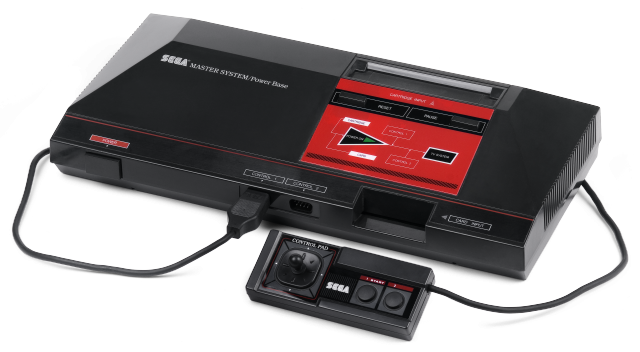
The Mark III, an updated home console released in Japan in 1985. Again, it suffered in competition against the dominant Famicom despite boasting superior hardware. In case you hadn’t realised, two generations of Sega console had now lost out to one Nintendo machine, this console war was off to a poor start to say the least. Over the next few years, the Mark III saw releases in worldwide regions as the Master System to varying degrees of success. Crucially, it did succeed in Europe and Brazil —markets Nintendo had failed to penetrate— despite the more diverse library and recognisable characters of Nintendo’s platform. On this topic, it’s interesting to note how Nintendo had forced its third-party developers to refrain from releasing their games elsewhere, which limited the Master System’s library and forced Sega to develop its own titles. Alex Kidd, a popular pre Sonic Sega mascot came as a result of this.

(Mega) Driven to Succeed
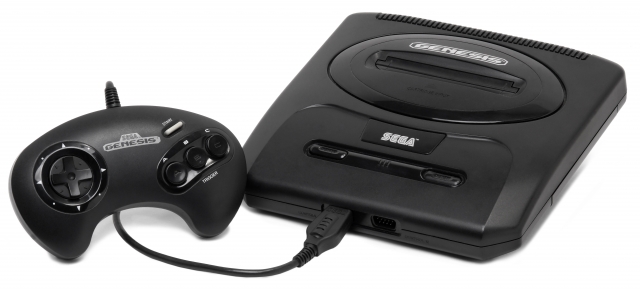
At the back end of the 1980s, Sega was enjoying at least some amount of success —either with home consoles or arcades—in every targeted region; it even opened two separate divisions to handle business operations in Europe and North America. The board was therefore perfectly laid out and every piece was in place for the company’s first resounding smash-hit home console: the Mega Drive (“Genesis” for those in the land of red, white and blue).
In a pattern that should be familiar by now, it launched first (October 1988) in Japan to disappointing but not disastrous sales figures before releasing a year or two later overseas to... well, not much better results. The Mega Drive may have eventually become a “smash-hit” but it certainly didn’t start out that way. Sega’s powerful 16-bit system would need a serious boost in public interest before reaching its ultimate heights, and a serious boost it received…
“Genesis does what Nintendon’t”. It’s a marketing slogan that has stuck in people’s minds for decades; yeah, it’s cheesy —especially in retrospect— but it so perfectly encapsulates how Sega finally struck a solid blow against the mammoth of Nintendo in the early to mid-90s. Sega’s percentage share of the home console market was in the single figures; it couldn’t compete with Nintendo head-to-head and so it didn’t even try. Instead, Sega honed in on doing everything Nintendo couldn’t or wouldn’t: (relatively) graphic violence, celebrity endorsements, ‘proper’ sports games and —most of all— attitude. The Mega Drive was to be the “grown-up” console for cool kids who had grown out of Nintendo.
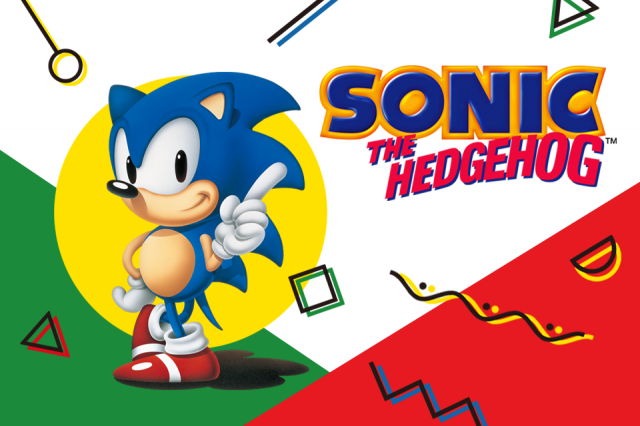
Sega’s bold new approach to tackling the Western market didn’t end here though: its final, crucial step was yet to be unveiled. Tireless work was being pumped into producing a mascot —a Mario killer— that represented Sega’s newfound attitude and offered an alternative to Nintendo’s more childish mascot who, at this point in time, had become a cultural icon and a veritable god among American children. Of course, I’m talking about Sonic the Hedgehog, the linchpin of Sega’s console efforts in the 90s and one of the major reasons the Mega Drive went on to sell 30 million units, with 65% of the home console market share. Sega had stolen the crown from Nintendo; for the first time since the early arcade days, Sega was on top again.
Sega on the Move
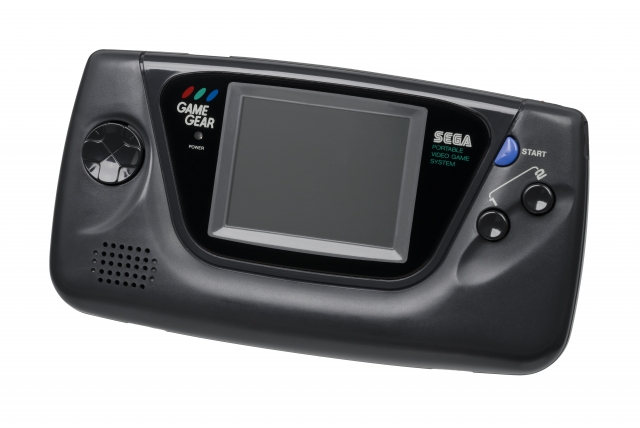 Around the same time of the Mega Drive release, Sega also launched a portable Game Boy competitor: The Game Gear. Hardware-wise, the console was on par with Sega’s earlier Master System and far surpassed anything the Game Boy could handle; its full-colour screen was a major selling-point. Unfortunately it was an absolute power-hog, the game library was lacking in “must-haves” and its monstrous size worked against the console’s purpose as a portable. Ultimately, the Game Boy won out, although not without a decent fight from the Game Gear (about 10 million units sold for the Game Gear and 60 million for the Game Boy).
Around the same time of the Mega Drive release, Sega also launched a portable Game Boy competitor: The Game Gear. Hardware-wise, the console was on par with Sega’s earlier Master System and far surpassed anything the Game Boy could handle; its full-colour screen was a major selling-point. Unfortunately it was an absolute power-hog, the game library was lacking in “must-haves” and its monstrous size worked against the console’s purpose as a portable. Ultimately, the Game Boy won out, although not without a decent fight from the Game Gear (about 10 million units sold for the Game Gear and 60 million for the Game Boy).
The ‘Hanger-Ons’
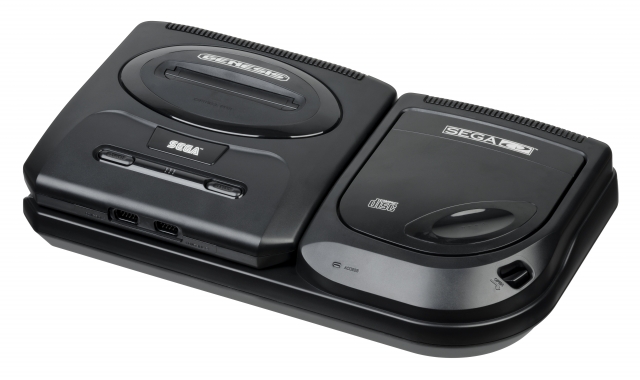 A Sega CD system
A Sega CD system
Console add-ons are an odd phenomenon that seem to have disappeared in the modern gaming world —probably for the best really. In the 90s, however, they were all the rage; Sega even came out with a couple of its own for the Mega Drive. The first add-on: Mega-CD (Sega CD in the USA), launched in 1993 in the UK and let the console read CD-based games with the advantage of a vastly increased storage size. This lead to a slew of Full-Motion Video (FMV) games like the infamous Night Trap and more ambitious versions of games that would have been found on the regular Mega Drive like Sonic CD.
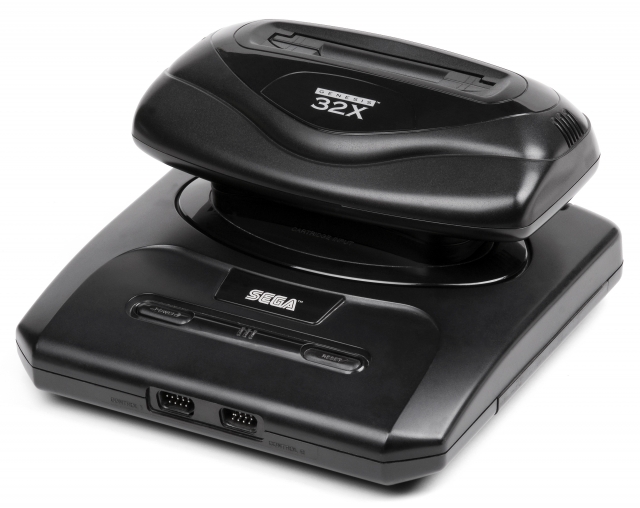 The 32X
The 32X
The other add-on: Mega Drive 32X, released in Europe in 1995 and tried to bridge the gap between the Mega Drive and its upcoming successor (more on that soon). Unlike the Mega-CD which enjoyed a modicum of success, the 32X was a complete flop and didn’t even break a million sales. Considering their respective releases at the start and end of the console generation, this makes sense: an add-on for a relatively new console holds potential, but why would anyone buy a bolt-on device for an almost obsolete console?
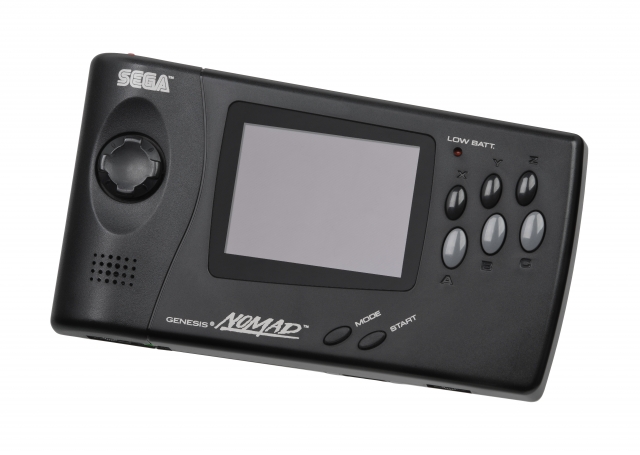 The Sega Nomad
The Sega Nomad
Sega was to make one more handheld console in 1995: the Sega Nomad. Released exclusively in North America, the Nomad could only play Mega Drive games and had no titles of its own. Sadly, much like the ill-fated Mega Drive add-ons, it failed; even Sega quickly abandoned the Nomad and it never saw a worldwide release.
An Educational Pit-Stop
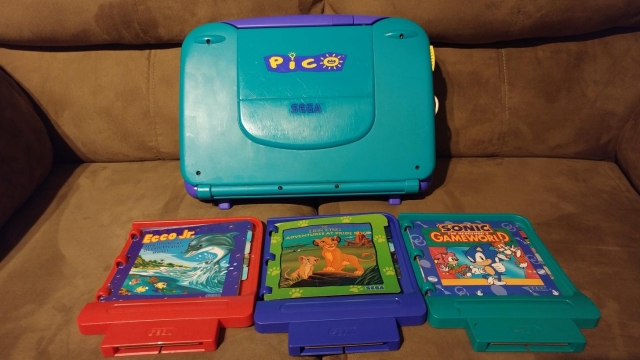
In a slight departure from what people had come to expect from Sega, it released the Pico worldwide in 93/94/95 (1994 in the EU). Less a traditional console and more a children’s educational toy, the Pico earns a mention here because of the educational Sonic games that released on the system: Sonic the Hedgehog’s Gameworld and Tails and the Music Maker. The Pico was also something of a success in Japan —in production all the way through to 2005 in some form— although it failed to gain much traction anywhere else.
Reach for the Stars
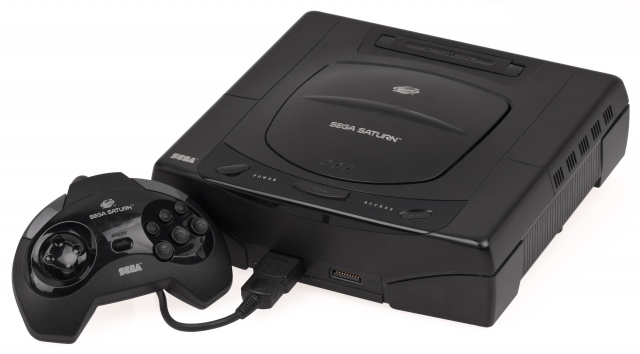
Now we’re back on track with the next proper home console from Sega. The Sega Saturn saw a 1995 release in Europe and ran CD-ROMs like its competitor, the Sony PlayStation. Sony was the new kid on the block for gaming; it aimed to steal the “cool crown” off Sega’s head and —truth be told— Sega did all but hand it to them…
Nintendo was the beast Sega knew, they had a rivalry —sure— but over the years the two companies had found a way to coexist by targeting somewhat separate demographics. Sony on the other hand, was a new and unpredictable threat whose debut console had the potential to rip the rug of confidence out from underneath Sega. Japan’s public was already starting to turn away from the “boring” Sega and towards the fresh-faced Sony; the same story was predicted overseas too. Its resulting plan of action made sense: release the Saturn in the US and EU months before Sony’s PlayStation and establish market dominance. It’s really a shame that the plan wasn't executed quite so well: when the Saturn unexpectedly launched after Sega’s 1995 E3 event, it genuinely took the whole industry by surprise —not in a good way.
Retailers weren’t ready, so the consoles were in short supply; developers weren’t ready, so the launch lineup was pitiful; and consumers weren’t ready, the 32X was still relatively new and messed with public understanding of what this brand-new machine even was. What’s more, the Saturn was a full $100 more expensive than the PlayStation ($399 as opposed to $299), a fact that Sony delighted in pointing out at its own E3 event directly following Sega’s. This, in conjunction with other advantages including Sony’s more developer-friendly architecture helped the PlayStation come out on top of the Saturn. Looking back, the numbers speak for themselves: over its lifetime, the Saturn sold a little over 9 million units while the PlayStation topped 100 million —and became the best-selling home console of its time.
The Saturn wasn’t without merit however: it gave players an array of good arcade ports in an age where “arcade-quality” was still a compliment. After all, Sega was still a goliath in the arcade scene and its home console had to reflect that. The Saturn also wasn’t short of significant exclusives either: NiGHTS Into Dreams..., Virtua Cop, Panzer Dragoon and Shining Force III being notable examples. Nowadays, the Saturn has managed to earn itself a few ardent supporters; for most people however, it’s generally considered another in a growing number of failures for Sega. Things were going from bad to worse and the company would have one more chance to regain the public’s favour, did Sega make it count? Well… it certainly tried, if nothing else.
Sweet Dreams
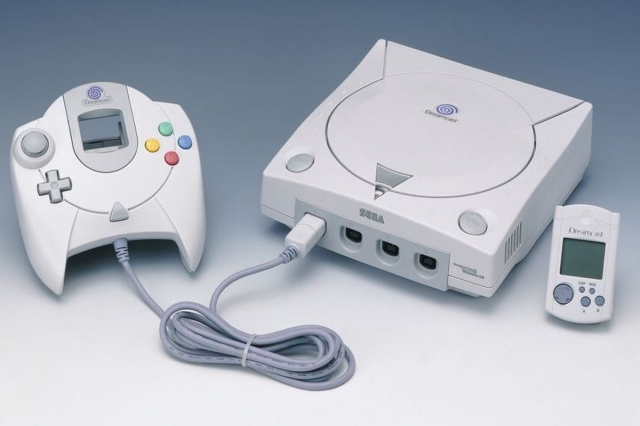
We come to the end of our story on a sad note that could have easily been triumphant and oh-so glorious. The Sega Dreamcast (released in Europe October 1999) once again launched before its Sony counterpart, the PlayStation 2 and enjoyed the initial benefits that came with an empty market. Sega had learnt its lesson after the Saturn’s “$399” fiasco too, and cut costs to bring the console’s launch price down to a comparative bargain of $199. Despite this, it was still the first console to sport built-in internet capabilities and supported online games like Quake III (although the experience didn’t compare favourably to online gaming on PC).
The signs were pointing towards a success for Sega; the Dreamcast’s library even boasted some stellar titles that are widely praised to this day: Shenmue, Jet Set Radio, Crazy Taxi, Sonic Adventure, Soulcalibur and Phantasy Star Online are among the titles still remembered and eagerly rallied behind in online discussion.
Sega’s absence from today’s lineup of consoles should tell you all you’d need to know about the Dreamcast’s fate: it flopped hard enough to force Sega out of the home console market and exclusively into the software business. What actually caused the Dreamcast to fail so spectacularly though? By all accounts it righted all the wrongs of the Saturn and should have been an absolute hit, shouldn’t it? Well, the answer’s not so simple.
First of all, the gaming audience had lost faith in Sega’s hardware division after an endless series of underperforming and sometimes poorly supported disasters. It’s sad to put it like this, but Sega never managed to recapture its Mega Drive glory days; by the Dreamcast’s release, most gamers had stopped expecting Sega to ever make a comeback. In many ways, the company’s failure was set in stone before its final console was ever released.
Secondly, (wildly exaggerated) rumours were flying around about the PlayStation 2’s incredible power and capabilities that made the Dreamcast look pitiful in contrast. Of course, the rumours were untrue —the PS2 was no missile-controlling supercomputer— but Sony wasn’t in a rush to discredit them when they helped make the PS2 such a desirable product.
Additionally, —and aside from the false rumours— Sony’s console genuinely did have the advantage of the DVD-ROM. Playing games in this format meant that the PlayStation 2 doubled as a DVD player and could therefore market itself as an affordable, all-in-one entertainment system, a hit with the growing casual gaming market. The Dreamcast’s proprietary GD-ROM format on the other hand, was infamous for its unreliability and obviously lacked the widespread appeal of the DVD.
What’s more, the format was initially chosen to curb piracy and yet —in an ironic twist— the Dreamcast’s incidental support of the CD-ROM format meant that piracy was actually a doddle on system. All of this, combined with the fact that EA and Squaresoft (two industry juggernauts) refused to touch the Dreamcast with a ten-foot pole, lead to the Dreamcast’s demise and Sega’s ultimate withdrawal from the home console business in 2001.
Light at the End of the Tunnel
Well there you go: we’ve gone through Sega’s entire console history from the SG-1000 to the Dreamcast. The company has certainly struggled in the home console market, but it struck gold once or twice and the endless determination it showed over the years is —in my humble opinion— worthy of our utmost respect. If only a couple of the company’s blunders had been avoided, perhaps there’d be a fourth major player in today’s console market… in another universe perhaps. Still, at least we can take comfort in the fact that Sega is alive and kicking to this day; publishing fan favourites like Yakuza, Alien Isolation, Bayonetta and Tembo the Badass Elephant, wait… what?!








COMMENTS